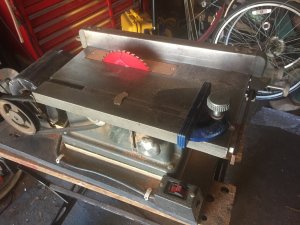- Joined
- Jul 26, 2013
- Messages
- 438
- Points
- 158

After being shanghaied by work for a year and a half, I am finally home at last. Today I had a chance to break out my hot rod model lumber saw. I have a little Proxxon bench saw and a Micromark tilting arbor saw- both nice machines within their limits, but in ripping down my own model wood I kept hitting those limits pretty hard. Living in a small city apartment also imposed other limits on equipment size. After thinking about it for a while, I started to look for an old tilting table bench saw. These were pretty common in the US in the 1930's through 1950's, but for a lot of reasons are not popular now. One of the main reasons is that they were sold as a bare tool without a motor, and that motor almost always got used for something else. These are usually very well made tools- they were not cheap when new, and are heavy, solid cast iron and well finished. Sears sold these as Dunlap, Companion or Craftsman brands, so search for them or tilting table saw. Bearings are simple and easily replaced brass bushings. All that I have seen use a 1/2" (13mm) arbor, the same as the old Dremel table saw and many different blades are available. After a bit of looking I found this machine on Craigslist for something like $20.00 US. It needed a thorough cleaning, lubrication and new bushings, but all of that was simple for me. I mounted the saw on a heavy board with a 1/2 HP 1725 RPM motor I salvaged out of an industrial fan. Probably overkill, but the saw does not bog down! Right now I am using a Freud carbide toothed trim saw blade which works great, has a thin kerf and leaves a nice smooth surface-
https://www.amazon.com/gp/product/B00008WQ2R/ref=oh_aui_search_detailpage?ie=UTF8&psc=1
The real advantages are that as a saw it is solid, has plenty of power and has a very good fence and miter- not micrometer adjusting, but once you have set it where you need it it will stay put. Fine adjustment does take some measuring and a tap hammer. I have not used the tilting table feature much, but it is nice to have for model size work. Using it for ripping a bevel on a 16 foot 2X4 would probably be a little terrifying. The table also adjusts up and down so almost any diameter blade can be used.
This was my solution to finding a high quality model saw that was still small enough to be put away on a shelf when I'm done. The mechanical work was not difficult, and I AM working on putting on a belt guard. Apologies on the background clutter! The hard drive magnet holding the miter in place shows another advantage- a magnetic iron table opens up bunch of possibilities for jigs and fixtures. Here is a link to the manual for the saw if any other tool geeks want to check it out:
http://vintagemachinery.org/pubs/detail.aspx?id=6521

https://www.amazon.com/gp/product/B00008WQ2R/ref=oh_aui_search_detailpage?ie=UTF8&psc=1
The real advantages are that as a saw it is solid, has plenty of power and has a very good fence and miter- not micrometer adjusting, but once you have set it where you need it it will stay put. Fine adjustment does take some measuring and a tap hammer. I have not used the tilting table feature much, but it is nice to have for model size work. Using it for ripping a bevel on a 16 foot 2X4 would probably be a little terrifying. The table also adjusts up and down so almost any diameter blade can be used.
This was my solution to finding a high quality model saw that was still small enough to be put away on a shelf when I'm done. The mechanical work was not difficult, and I AM working on putting on a belt guard. Apologies on the background clutter! The hard drive magnet holding the miter in place shows another advantage- a magnetic iron table opens up bunch of possibilities for jigs and fixtures. Here is a link to the manual for the saw if any other tool geeks want to check it out:
http://vintagemachinery.org/pubs/detail.aspx?id=6521



